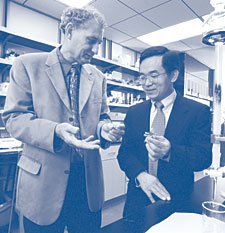
The Age of the Sensornet
But Dalton had a head start. He already holds the patent on opto-electronic modulators called opto-chips. These organic, microscopic devices are capable of converting electronic signals to light signals in computers, telephones, televisions and radar. The optical format transmits up to 100 gigabits per second (100 billion bits of information), and does so 10 times faster than current methods.
"Take the Internet, for example," says Dalton, asked to show how the technology best relates to the general public. "Our biggest problem there is the upload and download time. We've all sat there for 30 minutes waiting for something to load. That's because the electrical signal from your computer processor is sent through electrical wires into the power supply of a laser."
Imagine, he says, using the electronic computer processors sold by Intel, but replacing the coaxial cable with lightweight fiber.
"We have a chip that is built atop your computer processor," Dalton continues. "It sends the electrical signal up to a metal line that runs along an optical line. This stuff is like window glass. No energy loss and no absorption. Suddenly you can download hundreds if not thousands of times faster. The electro-optic modulators will allow communication in real-time. That's the fastest response time you can have."

Chemistry Professor Larry Dalton (left) shares his photonics expertise with Business Professor Michael Song, who heads the UW's Center for Technology Entrepreneurship. Photo by Dan Lamont.
From transportation to health, from energy management to crisis management, Dalton says the technology all comes down to sensing opportunities and crises before they happen.
"We have the Internet, and this is the Sensornet," he says. "Because we can communicate quickly by wireless means to the satellites and to fiber optics, it's conceivable that we can build buildings and homes with sensor-management systems so that some of the problems that occur in our lives could be monitored."
Envision having a house where a home computer serves as your command center: running your alarm system, detecting electrical circuitry, operating smoke alarms-even regulating your pet's doors. Dalton's plan, which goes even beyond the home, could also include:
- Earthquake detection: "If there's an earthquake on the way, you get a very early warning of it. And even if the building comes down, your sensors can tell you that someone's alive in a given region."
- Energy conservation: "The California energy crisis is not a crisis of energy supply; it's a crisis of energy management. If the power company knows when it will have energy demands and what is the basis of those demands, they can plan to deliver the required energy. If you have a room in your house where the lights have been on for 2 hours and no one is present, it will turn them off unless someone tells it not to."
- Medical assistance: A chip the size of a fingernail would automatically activate insulin release in diabetics or call an ambulance for heart attack victims-complete with identification and location.
- Anti-collision radar: "Conventional radar has moving parts and slow response times. Our new radars are super fast responders and immediately integrated with a microprocessor that computes the trajectory and the rates of approach to make a diagnostic call. An alarm will notify you: 'If you don't stop, you will hit this car or this train in 20 seconds.'"
The critical components of the NSF funding include not only the development of these kinds of technologies, but transferring them to the marketplace. That also means interacting with venture capitalists to create new corporations.
"We're committed in our strategic plan with NSF to create two new corporations (in Seattle) within five years, and that's a very conservative estimate," says Dalton. His discoveries have already sprouted one company that develops and markets his work, the Bothell firm Lumera (a division of Microvision).
- Page 3: Creating a High-Tech Workforce
- Page 4: Teaching Science Like Dr. Seuss
- Sidebar: Research Lights Up the Classroom
- Return to September 2002 Table of Contents